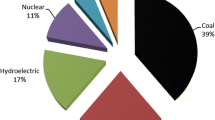Abstract
Nitric oxide (NO) and sulfur dioxide (SO2) are the major environmental pollutants being generated in the steel industry. More than half of NO and SO2 are emitted from sinter plants. Due to the catalytic effect of CaO in the sinter mix on the formation of NO and SO2, it might differ from that in the combustion of raw coals. In the combustion of raw coals, both NO and SO2 were formed in the temperature range of 473 K (200 °C) to 1623 K (1350 °C). In the case where the content of endogenous CaO in coal ash was high, the formation of SO2 was significantly reduced below 1473 K (1200 °C). In the case of the sinter mix, NO was formed in the temperature range of 473 K (200 °C) to 1173 K (900 °C) and the conversion of N to NO was increased by the catalytic effect of CaO in the sinter mix. Most of the SO2 was formed above 1473 K (1200 °C). The CaO present in the sinter mix reacted with the SO2 generated below 1473 K (1200 °C) to form CaSO4, the stability of which was maintained until 1473 K (1200 °C); thus, the conversion of S to SO2 was reduced. Based on the coal composition and functionalities of nitrogen and sulfur in coals, the indices of NO and SO2 were proposed to predict the conversion of N to NO and S to SO2, respectively. The increased heating rate shifted the formation temperature range of NO to higher temperatures and increased the formation of SO2 by the thermally activated decomposition of CaSO4.
















Similar content being viewed by others
References
J.N. Armor: Catal. Today., 1995, vol. 26, pp. 99–105.
P. Zelenka, W. Cartellieri, and P. Herzog: Appl. Catal. B: Environ., 1996, vol. 10, pp. 3–28.
Y.S. Kang, S.S. Kim, H.D. Lee, J.K. Kim, and S.C. Hong: Appl. Chem. Eng., 2011, vol. 22(2), pp. 219–23.
G. Li, C. Liu, M. Rao, Z. Fan, Z. You, Y. Zhang, and T. Jiang: ISIJ Int., 2014, vol. 54(1), pp. 37–42.
H. Yu, C. Zhang, and H. Wang: ISIJ Int., 2015, vol. 55(9), pp. 1876–81.
H. Hui, H. Hao, Z. Zhaowei, Z. Jinli, and Z. Quanzhong: Fresenius Environ. Bull., 2017, vol. 26(6), pp. 4194–201.
H. Zhou, P. Ma, M. Zhou, Z. Lai, and M. Cheng: J. Energy Inst., 2019, vol. 92(5), pp. 1476–86.
L. Tomas da Rocha, H. Kim, C. Lee, and S.M. Jung: Metall. Mater. Trans. B., 2020, vol. 51B, pp. 2068–78.
L. Tian, W. Yang, Z. Chen, X. Wang, H. Yang, and H. Chen: J. Energy Inst., 2016, vol. 89, pp. 264–70.
K. Zhang, S. Yang, S. Liu, J. Shangguan, W. Du, Z. Wang, and Z. Chang: ACS Omega., 2020, vol. 5, pp. 3047–54.
Z. Ouyang, J. Zhu, Q. Lu, Y. Yao, and J. Liu: Fuel., 2014, vol. 120, pp. 116–21.
M.S. Lee and S.C. Shim: ISIJ Int., 2004, vol. 44(3), pp. 470–5.
J. Pan, D. Zhu, X. Zhou, and Y. Luo: 4th International Conference on Bioinformatics and Biomedical Engineering, Chengdu, China, 2010.
J. Qie, C. Zhang, X. Li, Y. Guo, H. Wang, and S. Wu: ISIJ Int., 2017, vol. 57(12), pp. 2115–23.
C.D. Bontzolis, M.K. Petraki, and D.N. Spartinos: J. Chem. Technol. Biotechnol., 2019, vol. 94, pp. 3227–35.
L. Pang, Y. Shao, W. Zhong, and H. Liu: Fuel, 2020, vol. 264 (116795).
“Iron Ores—Method for Determination of Acid Soluble Iron (II) Content,” JIS M 8213, 1995.
L. Zhang, Z. Li, W. He, J. Li, X. Qi, J. Zhu, L. Zhao, and X. Zhang: Fuel., 2018, vol. 222, pp. 350–61.
W. Lv, X. Fan, X. Min, M. Gan, X. Chen, and Z. Ji: ISIJ Int., 2018, vol. 58(2), pp. 236–43.
J.M. Qie, C.X. Zhang, F.Q. Shangguan, X.P. Li, and J.C. Zhou: Trans. Ind. Inst. Met., 2020, vol. 73, pp. 35–45.
S. Cho, L. Tomas da Rocha, B.J. Chung, and S.M. Jung: Metall. Mater. Trans. B., 2021, vol. 52B, pp. 2676–86.
D.F. Gonzalez, I.R. Bustinza, J. Mochon, C.G. Gasca, and L.F. Verdeja: Min. Process. Extract. Metall. Rev., 2017, vol. 38(4), pp. 254–64.
A.E. Newkirk: 137th Meeting American Chemical Society, Division of Analytical Chemistry, Symposium Thermal Methods of Analysis, OH, 1960.
Conflict of interest
On behalf of all authors, the corresponding author states that there is no conflict of interest.
Author information
Authors and Affiliations
Corresponding author
Additional information
Publisher's Note
Springer Nature remains neutral with regard to jurisdictional claims in published maps and institutional affiliations.
Manuscript submitted July 18, 2021; accepted September 26, 2021.
Rights and permissions
About this article
Cite this article
Cho, S., Tomas Da Rocha, L., Chung, BJ. et al. Formation of NO and SO2 in the Sintering Process of Iron Ores. Metall Mater Trans B 53, 84–95 (2022). https://doi.org/10.1007/s11663-021-02341-0
Received:
Accepted:
Published:
Issue Date:
DOI: https://doi.org/10.1007/s11663-021-02341-0




